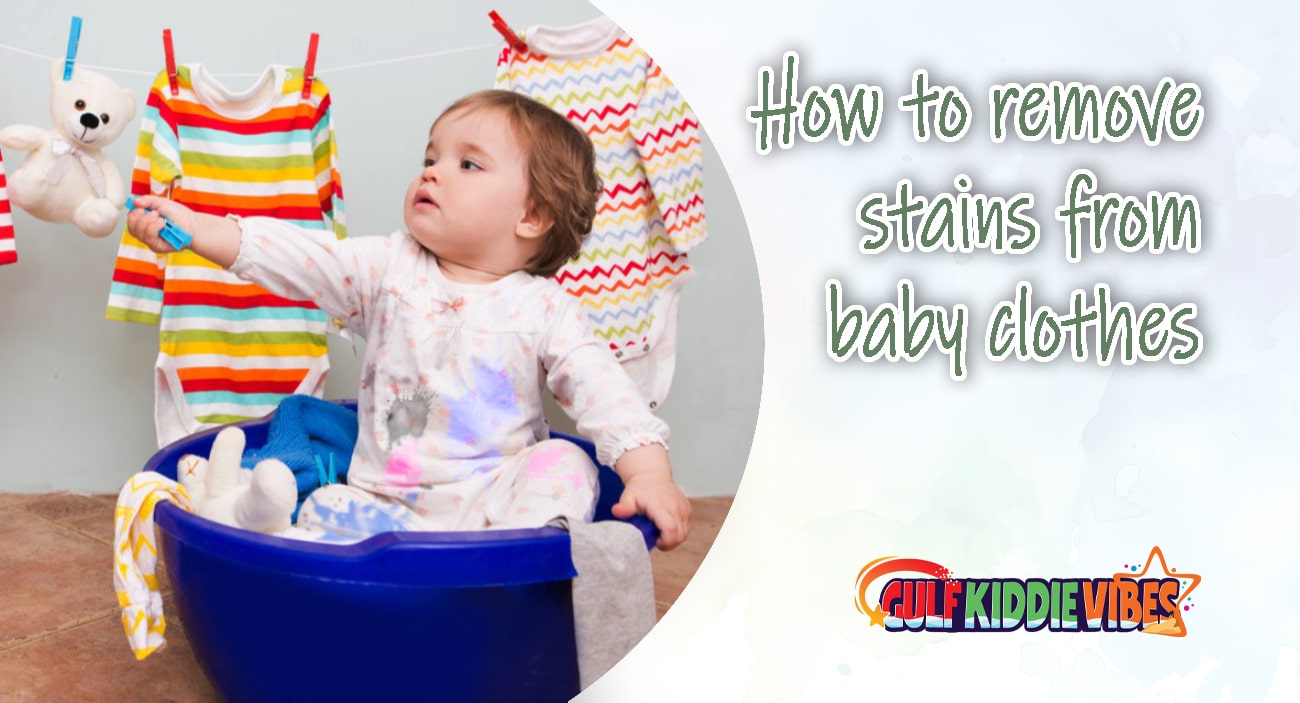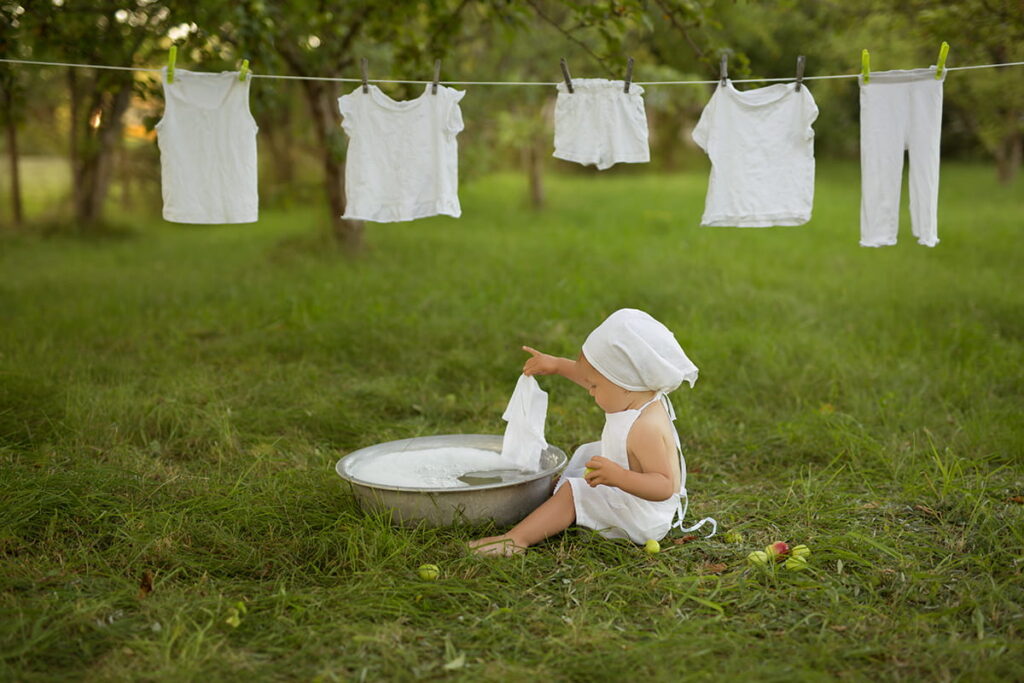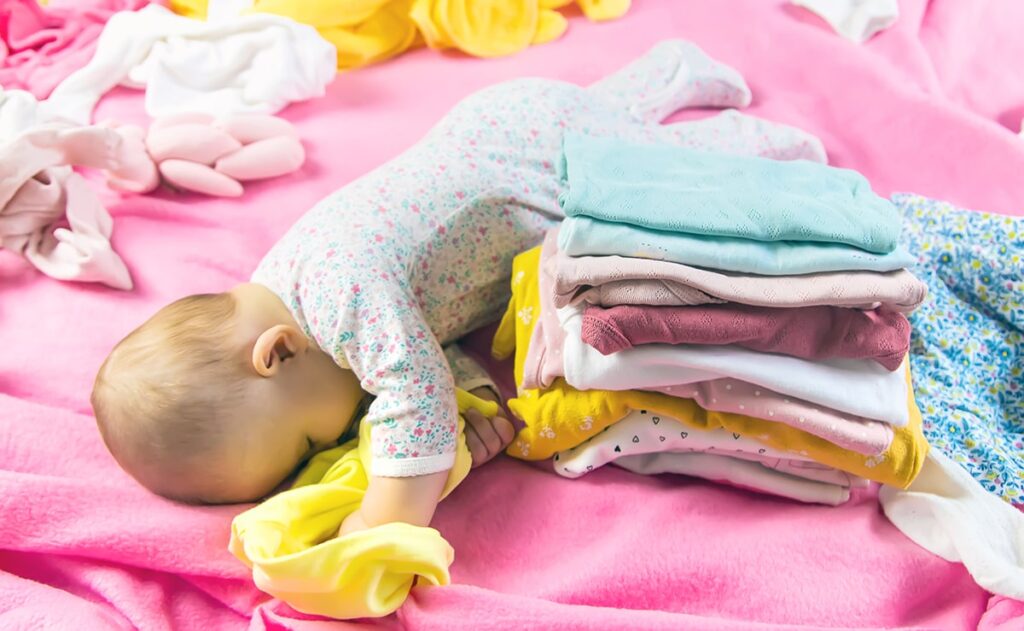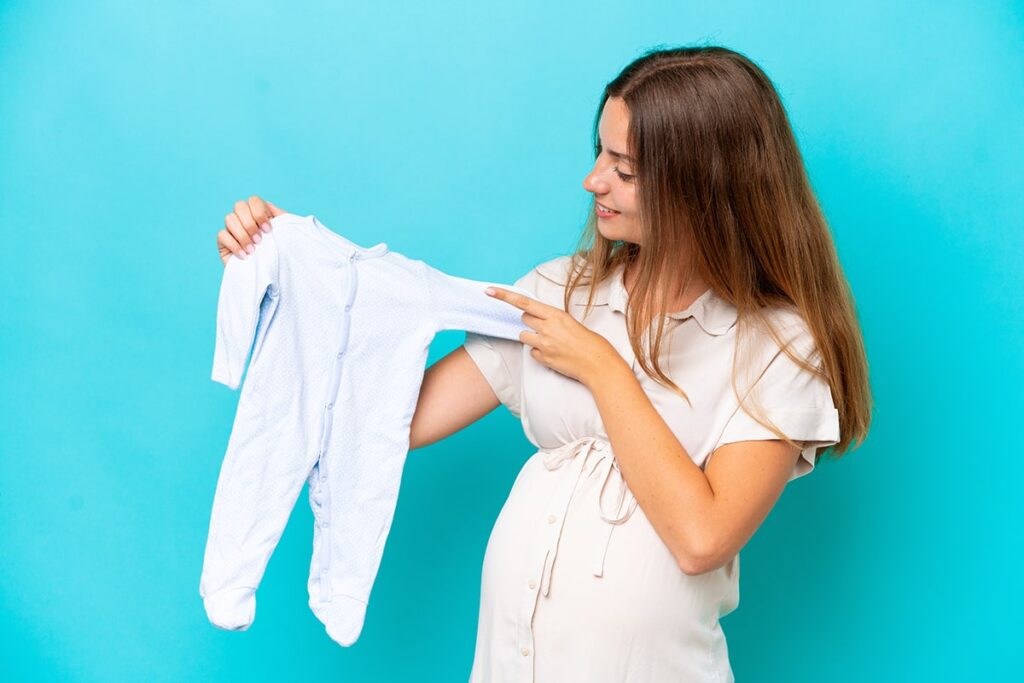
How to Remove Stains from Baby Clothes: A Complete Guide
How to remove stains from baby clothes? Easy! Act fast by rinsing or blotting the stain to stop it from setting, then tackle it with natural solutions like baking soda, vinegar, or lemon juice. For tougher messes, reach for baby-safe stain removers and always check fabric care labels. Stay ahead of stains by using bibs, layering outfits, and keeping cleaning supplies handy. With these tips, parents can confidently keep their baby’s wardrobe looking fresh and spotless!
Table of Contents
Feeding your baby is already a challenge, but ensuring their clothes are free of stains seems almost impossible for some parents. Babies don’t know how to eat without making a mess, and more importantly, they can’t in the first place. As such, there will be stains on your baby’s clothes.
So how to remove stains for baby clothes? Depending on the type of stain, you will need to take different approaches. For some stains, just cold water and natural stain remover like vinegar or soda paste is enough. But for others you might be needing commercial baby-safe stain removing chemicals.
As you can see, many methods exist for removing stains from baby clothes. You and I will be exploring them all in this article. From stain types, pre-treatment options, removal options, and even prevention methods will be explored for all new parents. So buckle up, and let’s get to cleaning those baby spills, leaks, and other baby stains.
Understanding Baby Clothes Stains

Before I discuss how to remove stains from baby clothes, I need to educate parents like you on the different types. Believe it or not, different stains babies make require different solutions. Using one solution for one stain type won’t work; instead, you might make it worse.
Types of Stains
Many types of stains can be found in baby clothes, but I organized them into four main categories. Here they are:
Food stains
One of the most common types of stains on baby clothes parents remove is food stains. Babies leave stains on baby clothes daily from baby food, mashed fruits, and formula or milk. Some of these stains, if not removed quickly, will stain (duh) those clothes forever.
Bodily fluid
Babies aren’t known for having the best control over their bodily fluids, so they leave stains on their clothes. Bodily fluids such as spit-ups, drool, and diaper leaks are common. Because of their make-up, these stains are hard to remove and require more than just water.
Outdoor stains
Babies don’t run around a lot while outdoors at a young age, but they do when they are a few years older. All that running around will lead to parents having to look up how to remove stains from baby clothes. Common outdoor stains on clothes come from grass, mud, and dust. These are some of the easier stains to remove, requiring only cold water and some elbow grease.
Other types
All other stains on baby clothes that I couldn’t put into the other groups fall here. Stains caused by crayons, medicine, etc., will require specific removal techniques.
Why Baby Stains Are Challenging
Aside from all the different types of stains, there are other reasons why removing stains from baby clothes is challenging for parents. Here are a few of those reasons:
- Delicate fabrics:
- Baby clothes are made of delicate materials, meaning they must be handled carefully.
- Any stains on them can’t be just scrubbed away as that might damage the clothing.
- Quick-setting stains:
- Certain stains, like from food or bodily fluids, tend to set quickly.
- This makes removing them quite difficult if you don’t start fast.
- Frequent washing:
- Baby clothes require frequent washing due to fear of stains and spills.
- This wears out the fabrics, thus reducing their lifespan.
Pre-Treatment Tips for Baby Clothes Stains

The first step in removing stains from baby clothes is to pre-treat the clothes. This will make it easier to remove the stains using the methods I will be going over next. The steps to pre-treating clothes are:
Act Quickly
The major step to removing stains from baby clothes is for parents to act quickly. If you take too long to remove stains from food, spit-up, or diaper leaks, then you run the risk of the stains setting. If that happens, it will take much longer or impossible to remove.
I highly recommend rinsing the stained clothes under cold water, not warm water, as soon as you see them. The cold water will ensure the stain doesn’t set, which can happen if rinsed under warm water. If rinsing isn’t possible due to being outdoors, then use a wet wipe or damp cloth to blot the stained area.
Rinse or Blot, Don’t Rub
To remove stains from baby clothes, you must be careful. If you get impatient, you will only make the stain worse. Too many parents make the mistake of rubbing or scrubbing the stain, which may cause the stain to go deeper or damage them.
I now recommend blotting the stained area instead of rubbing it. This gentler approach will make removing the stain easier later. You can also rinse the cloth, but this should be done when you are at home.
Check Fabric Care Labels
Since baby clothes are delicate, manufacturers provide specific instructions for cleaning them properly. These fabric care labels provide information on how to wash, dry, and even remove stains from them. Trying to remove stains from baby clothes without reading the information on the labels will only hinder you.
Check the symbols and the instructions on the label. Follow them if you have to when removing stains. Doing so will ensure you care for the clothes and extend their lifespan.
Effective Stain Removal Methods for Baby Clothes
It’s time to review our top suggestions for removing stains from baby clothes. These recommendations are the best because I have tested them and taken suggestions from parents with babies. I have methods, natural and commercial, as well as washing tips, so you will be covered.
Natural Stain Removers
Rather than using chemicals to remove stains from baby clothes, I recommend you try something more natural. Natural stain removers work surprisingly well and are easy to make at home.
Baking soda
The baking soda paste is a favorite amongst parents because of how easy it is to make and how effective it is. Here is how you can remove stains with this paste:
- Blend 2-3 tbs of baking soda with just a bit of water.
- Apply the mixed paste over the stained area.
- Gently rub, not scrub, the paste with your finger or soft brush.
- Let the mixture sit for about 15-20 minutes.
- Rinse the paste off under cold water.
The baking soda paste is an effective mixture for removing stains from food, grease, and odor. The mixture is also fabric-safe, which makes it ideal for putting on baby clothes.
Vinegar
Another natural solution to removing stains from baby clothes is vinegar, specifically white vinegar. This vinegar type is quite effective at removing stains like spit-up, diaper leaks, and sweat. It also leaves the baby’s clothes odor-free. Since you don’t need to mix anything with it, it’s a top choice for parents looking for a quick solution.
Here is how you use it:
- Put an equal part of white vinegar and water into a spray bottle.
- Spray the solution onto the stained area.
- Let the solution sit for about 10-15 minutes.
- Rinse the baby cloth under cold water.
- Repeat steps 2-4 if the stain isn’t completely removed.
Commercial Stain Removers
Some stains are just too stubborn and require something a bit more to remove them. That’s where commercial stain removers come in. These have chemicals that break down the stain, making it easier to remove it.
Baby-safe stain remover
Even though I am asking you to choose a commercial stain remover, it doesn’t mean you can go with just any old one. The remover must be baby-safe since you will remove stains from baby clothes. Many products market themselves as baby-safe, but some don’t. Here are some I know to be baby-safe:
- Dreft stain remover:
- This strain-removing brand is both gentle and effective on baby clothes.
- Ideal for removing food, spit-up, and diaper stains.
- Puracy natural stain remover:
- Puracy makes its stain remover with natural plant-based ingredients.
- This makes it safe for the skin and works on various stains.
- OxiClean baby stain remover:
- This brand uses an oxygen-based cleaner that works quite well on tough stains.
- The product is also quite gentle on baby clothes, so parents are encouraged to use it.
Using commercial stain removers requires you to use them in a specific manner. Here are the steps to using them effectively for removing stains from baby clothes:
- Use a small amount on a small part of the baby clothes to see if it works well.
- Apply the remover using the instructions it comes with.
- Wait between five and ten minutes for the remover to do its work.
- Wash the baby’s clothes gently using baby-safe detergents.
I don’t blame you if you aren’t 100% sure about using commercial stain remover on baby clothes. But you want the strength of the commercial products to remove tough stains from baby clothes.
The solution would be a DIY stain remover that’s as powerful. Here is how you can make and use it:
- Mix together 1 cup of hydrogen peroxide, ½ cup of baking soda, and a few drops of baby-safe dish soap.
- Spray the blend on top of the stain and wait for 20 minutes.
- Rinse gently and wash the baby’s clothes as usual.
Once you have used stain removers on baby clothes, you must wash them properly to finish the process. I have found that there are two main ways to wash baby clothes: machine or hand washing.
Related: How to Get Baby Oil Out of Clothes? Tried and Tested Ways
Machine Washing Tips

Here are some tips on choosing the right detergent and water temperature that will help you wash baby clothes and remove stains.
Detergent
When you are looking for the right detergents, you will need to consider whether they are:
- Baby-safe:
- These detergents are safe for babies because they are free of chemicals, fragrances, and dyes.
- I recommend Dreft, Seventh Generation Free & Clear, or All Free Clear.
- Hypoallergenic:
- I recommend a hypoallergenic detergent for babies with sensitive skin or eczema.
- I suggest you find one that’s dermatologist-tested and fragrance-free.
Water temperature
I have found that you can use three water temperature levels to wash clothes, but not all of them are suitable for baby clothes. Here is some more information:
- Cold water:
- Best for making sure that stains don’t become permanent and keep the fabric color safe.
- Use on baby clothes with brighter or darker colors.
- Warm water:
- It should be used to remove grease and oil-based stains.
- You can also use it to clean heavily soiled items or whites.
- Hot water:
- You shouldn’t use hot water to wash or remove stains from baby clothes.
Hand Washing Tips
If you don’t want to or can’t use a machine to wash baby clothes, you can always use hand washing. Here is the process I use for hand-washing baby clothes:
Step-by-step guide
- Fill a basin:
- Fill a clean basin or sink with lukewarm water, which won’t harm delicate baby clothes.
- Add detergent:
- Add a bit of baby-safe detergent to the water and swirl it to make suds.
- Soak the garment:
- Dunk your baby’s clothes into the sudsy water and let them soak for 15-30 minutes.
- Clothes with tougher stains will require you to agitate the water.
- Gently scrub:
- Use a soft brush or fingers to scrub, not rub, the stained area.
- Be gentle so as to not damage the delicate fabrics.
- Rinse thoroughly:
- Rinse the washed clothes under cold water to ensure no residues remain.
- Residues will irritate the baby’s skin.
- Dry properly:
- Air-dry all the washed and rinsed clothes.
- Hang them to ensure they don’t stretch or damage the fabric.
Specific Stain Removal Techniques

While the process of removing stains from baby clothes I have shared works with most clothes, some will need extra work. So here are some specific stain removal techniques that should help you out if you are having problems.
Removing Food Stains
To remove food stains from baby clothes, you won’t have to do anything too different, but you will have to act quickly. Otherwise, the stains will become tougher to remove, leaving your clothes discolored. Here is how to remove food stains:
- Scrape off excess food:
- Remove any sticky or solid food bits from the clothes, leaving only the stains.
- Don’t be forceful; that will only make the stain deeper.
- Rinse immediately:
- Rinse the baby’s clothes under cold water to remove as much of the stain as possible.
- Don’t use hot water, which will only worsen the stain.
- Apply a stain remover:
- If there is still some stain remaining, then use any of the stain remover, natural or chemical, I went over above.
- Be gentle to ensure the removal process is successful.
- Wash as usual:
- Once the stain is removed, wash the baby’s clothes using the abovementioned process.
- Both the machine and the hand washing method are suitable.
Removing Bodily Fluid Stains

Parents will become quite used to removing spit-up, diaper leaks, and drool, so here is how to make the removal process easier for you. The steps are:
- Rinse immediately:
- Start by rinsing the stain under cold water, just like above.
- Don’t use hot water because that makes the stain harder to remove.
- Pre-treat the stain:
- Use either a commercial cleaner or the vinegar solution to break down the stain more.
- Wash in warm water:
- Wash the clothes using baby-safe detergent and either a machine or by hand under warm water.
- Check before drying:
- Before drying the clothes, inspect them.
- If there is some stain remaining, repeat the process.
- If not, then air-dry them for the proper drying.
Removing Outdoor Stains
If babies play outside, they stain their clothes with grass, mud, and dirt. In those cases, here is how you remove them:
- Let the mud dry:
- To ensure you can remove the stain completely, allow the mud to dry.
- Once dry, brush it to leave only the stain.
- Rinse thoroughly:
- Rinse the baby clothes with stains under cold water.
- Be gentle in removing as much stain as possible without any fabric damage.
- Apply a stain remover:
- Outdoor stains are hard to remove; therefore, I suggest using either commercial or DIY stain remover.
- Use only a small amount and follow my guide for proper stain removal.
- Wash in warm water:
- Wash the clothes in warm water and baby-safe detergent.
- Use more detergent if the stain is stubborn.
Removing Miscellaneous Stains
Other types of stains will require specialized techniques that I haven’t covered yet. The process is as follows:
- Blot the stain:
- Using a clean cloth or towel, blot, not run, the stain to remove as much excess as possible.
- Apply rubbing alcohol:
- Use a small amount of rubbing alcohol with a cotton ball.
- Dab with it to remove the stain.
- Use dish soap:
- Then, gently scrub the baby’s clothes using some dish soap to remove stains completely from baby clothes.
- Wash as usual:
- Wash the clothes in warm water using either a machine or by hand.
Frequently Asked Questions
What is the best way to remove old, set-in stains from baby clothes?
For old stains, try soaking the garment in a mixture of warm water and oxygen-based bleach for 30 minutes before washing. Avoid using chlorine bleach, as it can damage fabrics and irritate a baby’s skin.
Can I use bleach on baby clothes?
Avoid chlorine bleach, as it can weaken fabrics and cause skin irritation. Instead, opt for oxygen-based bleach or natural alternatives like baking soda and lemon juice.
How do I remove yellow stains from baby clothes?
Yellow stains are often caused by sweat or spit-up. To remove them, apply a paste of baking soda and water to the stain, let it sit for 15-20 minutes, and then wash the garment in warm water.
Are natural stain removers effective?
Natural stain removers like baking soda, vinegar, and lemon juice can be very effective, especially for fresh stains. However, you may need to use a commercial baby-safe stain remover for tougher or set-in stains.
Conclusion
There are many answers to how to remove stains from baby clothes because different stains require different processes. From food, bodily fluids, outdoor, and miscellaneous stains, each requires you to remove them differently. However, all of them do cover the same steps. Firstly, you rinse or remove excess stuff, then remove the stain, followed by washing and drying the clothes.
Regardless of the type of stain, following the guides I have shared will be more than enough for any new or old parent to remove stains more easily. Happy cleaning!






